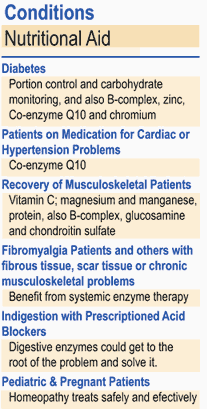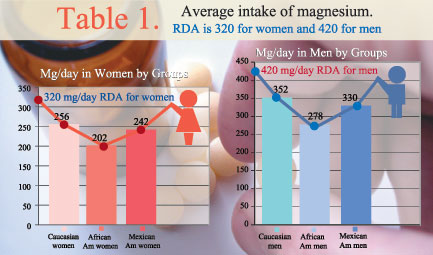In our culture, we are finding that most patients are open to new ideas and desire to explore alternative therapies to answer their healthcare needs. Such progressivism is great, but that openness has spawned an enormous and sometimes unwieldy explosion in alternative healthcare products, procedures, and professions in the market today.
In the vast ocean of health products, from nutritional supplements to herbs to dietary protocols, prescribing a nutritional curriculum for our patients becomes a complicated and onerous task. In addition to wading through these products, we also have to contend with the reality that specific protocols within nutrition can be antagonistic toward others, relatively competing for biochemical position. The balancing of body chemistry can evolve into a juggling contest more problematic than we are able or willing to handle.

As we increase our efforts in nutrition, we sometimes end up giving our patients more pills than they can swallow. We find ourselves in what I call a “shopping bag” nutritional practice—that is, patients are loaded up with a shopping bag full of products and a list of instructions as long as their arm on how, when, and where to take them. This difficulty usually adds frustration, and patient compliance and confidence frequently falls off, not only in the nutritional treatment, but also in the one who provides it.
Don’t misunderstand. A good lifestyle management program, including nutritional guidelines, is an imperative foundation for optimal health. I’m not recommending that you give up on this valuable therapy, rather that it be used in its most efficacious role for both the patient and the doctor.
While nutrition and herbs are more supportive in their therapeutic effects, chiropractic and homeopathy are more curative. Homeopathy offers a deeper acting therapy to better address the roots of disease. While nutrition works on a biochemical level, homeopathy works bioenergetically, correcting nerve interferences throughout the whole nervous system where the hands of the chiropractor cannot reach.
Homeopathy, like chiropractic, works at the highest levels in the hierarchy of our health to maintain homeostasis. The marriage of chiropractic and homeopathy empowers the chiropractor to more successfully work with the whole nervous system to better fulfill the high call of chiropractic. It also allows additional therapies, like nutrition, the opportunity to maximize their potential. Homeopathy is essential to completing chiropractic destiny, and without it, chiropractic can never realize its full potential.
With the application of both of these modalities to clear nerve interferences throughout our entire control system, everything we do to enhance our patients’ health works better: application of nutrition, herbs, diet, exercise, etc. We will commonly even see improvement in the ability to think and believe more positively and even observe the correction of recurring subluxation patterns.
The protocol of chiropractic and homeopathy using nutrition as a supportive modality definitely helps the practitioner look better from the patients’ perspective. Everyone wants to go to the practitioner who helps people with problems no other doctors could—especially when they are helped using less time, money and effort.
Nutrition and herbs are great therapies; they are essential to a wellness practice. However, using chiropractic and homeopathy as our primary tools, our natural programs are no longer limited to the biochemical realm, and we are better equipped to correct problems at the highest levels in the hierarchy of health. Instead, we can now treat the whole person both biochemically and bioenergetically, eliminating the need to force results by over-treating patients with the limitations of one or two modalities excessively.
The majority of the public is affected by some so-called incurable problem or recurring health issue irresolvable with nutrition, traditional medicine, or even chiropractic alone. These people are open to, hungry for—even hoping and praying for—someone to come along with an answer to their dilemma. Dis-ease has been robbing people of their quality of life for too long, and they are seeking a doctor willing to step up to the plate to try to help them.
I encourage you to try homeopathy. Whether you just want to improve your effectiveness as a musculosketal practitioner, or move more successfully into a full-fledged eclectic style practice, homeopathy holds an essential power position for the chiropractor wanting to maximize results! TAC
Frank J. King, Jr., is a nationally recognized researcher, author and lecturer on homeopathy. In addition, Dr. King is the founder and director of King Bio Pharmaceuticals, a registered homeopathic manufacturing company dedicated to completing chiropractic destiny with the marriage of homeopathy. Dr. King offers, complimentary to all Doctors of Chiropractic, his turnkey procedural system for the high volume practice called, The Chiropractic Enhancer systemÔ (CES). It is so easy to use that you can successfully apply homeopathy in your practice using any company’s products in one day. Call King Bio Pharma-ceuticals, Asheville, N.C. 1-800-543-3245 or e-mail: [email protected].



 fibrous tissue, scar tissue or chronic musculoskeletal problems can benefit from systemic enzyme therapy. And how about the many patients on some of the prescription acid blockers for digestive upsets. A digestive enzyme could get to the root of the problem and your patient may find the problems of indigestion are over. Homeopathic remedies are my favorite with pediatric and pregnant patients, because of the safety and effectiveness of these products.
fibrous tissue, scar tissue or chronic musculoskeletal problems can benefit from systemic enzyme therapy. And how about the many patients on some of the prescription acid blockers for digestive upsets. A digestive enzyme could get to the root of the problem and your patient may find the problems of indigestion are over. Homeopathic remedies are my favorite with pediatric and pregnant patients, because of the safety and effectiveness of these products. your door! The addition of nutrients to your practice will add to the health of your patients and their families. This will translate into greater income for your office, more regular follow up with patients and many more referrals. It is a daily occurrence for a patient to come to my facility and ask to be evaluated and treated medically or with chiropractic, and to end up being treated nutritionally also. The patient has a happier, healthier outcome and a real plan for wellness when they are finished with their visit.
your door! The addition of nutrients to your practice will add to the health of your patients and their families. This will translate into greater income for your office, more regular follow up with patients and many more referrals. It is a daily occurrence for a patient to come to my facility and ask to be evaluated and treated medically or with chiropractic, and to end up being treated nutritionally also. The patient has a happier, healthier outcome and a real plan for wellness when they are finished with their visit. 




